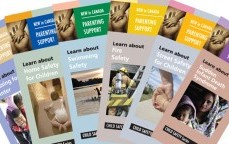New in Canada: Multilingual Parenting Brochures
 The CMAS New in Canada Parenting Support Brochures, available in English, French, Arabic, Cantonese, Korean, Mandarin, Farsi, Punjabi, Russian, Spanish, Tamil, and Urdu, give accessible, practical support to parents coping with basic safety issues for their young children in an unfamiliar cultural setting, with climactic conditions that may be very different to that of their previous home.
The six brochures cover:
The CMAS New in Canada Parenting Support Brochures, available in English, French, Arabic, Cantonese, Korean, Mandarin, Farsi, Punjabi, Russian, Spanish, Tamil, and Urdu, give accessible, practical support to parents coping with basic safety issues for their young children in an unfamiliar cultural setting, with climactic conditions that may be very different to that of their previous home.
The six brochures cover:
- Dressing for Winter: Includes tips for appropriate clothing for different temperatures along with recommendations for safe time lengths of outdoor play during extreme weather conditions, the rationale for using multiple thin layers of clothing in cold weather, along with basic prevention, recognition and first aid treatment for frostbite and hypothermia.
- Fire Safety: Covers the most common causes of household fires (cooking, home heating, electrical problems, smoking, candles and children playing with fire); makes a strong case for installing smoke detectors and carbon monoxide detectors; outlines simple fire prevention practices in the home, and the steps to take if smoke or flames are discovered, including the importance of developing a Fire Safety Plan for getting your family safely out of the building in an emergency.
- Home Safety for Children: Outlines the most common causes of injury for young children in the home, provides tips for improving safety in the home both through practical prevention measures and through the development of basic daily routines that help to prevent accidents.
- SIDS: Gives 10 steps to help prevent SIDS, along with the Health Canada website link to access information on approved cribs and other safety information; gives a basic explanation of SIDS; recommends having a baby sleep on their back in a toy-free crib next to the parent’s bed (rather than in the parent’s bed) and promotes breast-feeding.
- Swimming Safety: Drowning is the second leading cause of injury-related death for children under the age of 10 in Canada, and about one-third of these deaths occur when the child is not being monitored by an adult. The brochure stresses the importance of supervision and, in the case of children under 5, having a caregiver within arm’s length at all times whilst the child is in the water. A strong recommendation is made for parents to learn to swim themselves, and learn First Aid and CPR, and for the use of lifejackets by young children and weak swimmers.
- Street Safety: Explains why young children are more vulnerable to pedestrian injuries and deaths, and emphasizes the importance of modeling and starting early with road safety training, continuing the training in incremental steps as the child passes new developmental markers.
Click here to access these great resources.
